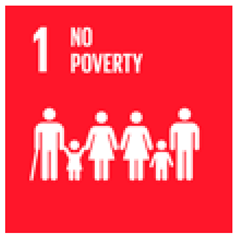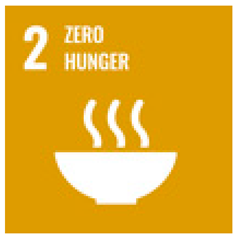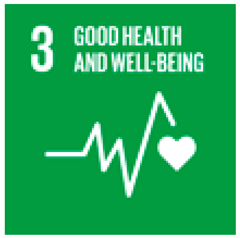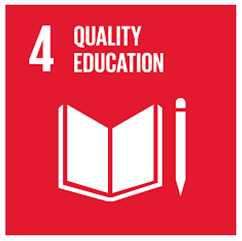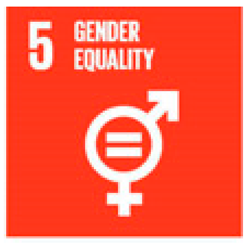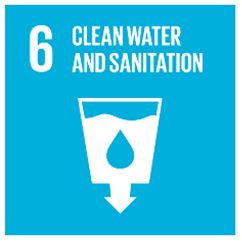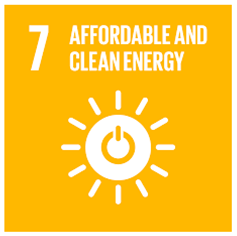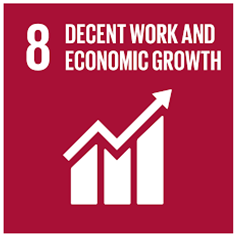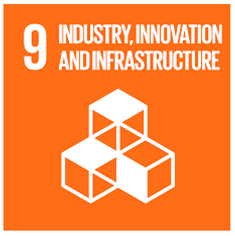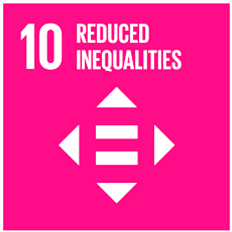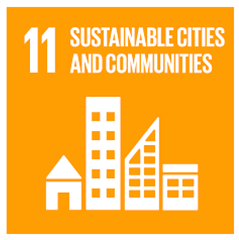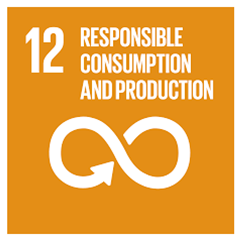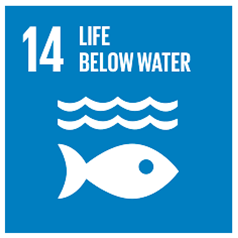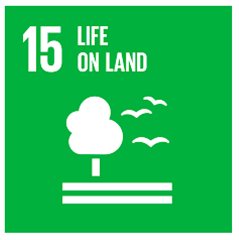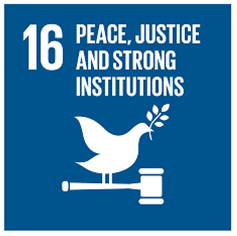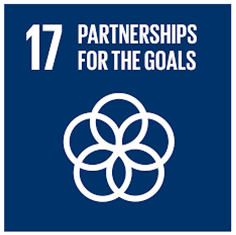Abstract
In the context of flood research, scholars and practitioners have recognised that Western-knowledge-driven engineering-based flood management techniques are insufficient for successful water use and management in urban design and planning practices, while ideas, practices, and knowledge from local people are essential. Traditional water knowledge (TWK) explains people’s profound understanding of natural processes and the ecological dependencies of water systems and connections with their local water system and the land, beliefs, sense, and practices that are an integral part of their culture. However, the concept of traditional knowledge may differ from scientific knowledge, as it represents a different worldview perspective from a modern Westernised world. Considering Khulna City, Bangladesh, as a case, this paper investigates the salient challenges and opportunities to integrate TWK with present urban design and planning practices. Interviews were conducted with key stakeholders, including relevant government officials, NGO workers, researchers, urban professionals, and local elders. This study finds that TWK can contribute to urban design and planning practices by identifying helpful ecosystem services and site-specific information; by sharing strategies for surface water protection, open-space design, and rainwater harvesting; and encouraging design of spaces for psychological benefit, and ensuring sustainability and building flood resilience in an urban context. Furthermore, this research demonstrates how these elements relate to the Sustainable Development Goals (SDGs). However, issues with knowledge transmission, the identification of the actual knowledge holders, poor governance, weak urban planning, minimal institutional capacity, and perceived cultural inferiority are significant challenges restricting the integration of TWK, despite its relevance to sustainability. This paper suggests that considering traditional water use and management is necessary to develop flood resilience in an urban context in a sustainable way.
1. Introduction
The Sustainable Development Goals (SDGs) of the United Nations provide an evidence- and science-based framework for protecting the environment, balancing economic progress, and “ensuring peace and prosperity for all people by 2030” [1]. This process created a set of 17 goals, 169 targets, and 232 indicators described as “integrated and indivisible, global in nature and universally applicable” [2,3]. The SDGs frame sustainability as a paradigm for thinking about the future, providing opportunities and challenges for individual nations based on their own distinctiveness and perceptions. According to Wang et al. [4], keeping its interconnection with economic growth, urban sustainability research will continue to advance and must be closely linked to the Sustainable Development Goals (SDGs). A significant body of literature on SDG “localisation” has resulted from the recent uptick in interest in supporting city-level initiatives to address global issues like climate change and numerous localisation initiatives have been launched in cities all over the world [5,6]. Another approach to addressing the challenges related to sustainable development is to utilise traditional knowledge and local resources [7], which is globally known as the theory of Traditional Ecological Knowledge (TEK). TEK is an information source that embodies different perspectives and knowledge of locally developed practices of resource use, focused on the ecological relationship with other natural elements as understood through interactions between human communities and their local ecosystems [8,9,10,11]. To support policy choices for sustainable solutions, knowledge of TEK aids in developing critical, evaluative, and creative thinking abilities [12]. Kumar et al. [1] mapped the TEK literature with the targets of SDGs and revealed that 7 of the 17 SDGs are linked to the concept of TEK. In a different study, Das et al. [13] identified that 12 of the SDGs can be achieved through TEK implementation. Both studies argue that, to achieve the SDGs’ intended outcomes, stakeholders must include those with local traditional knowledge. When this TEK is encouraged and implemented, an integrated approach involving a blend of TEK and scientific knowledge can contribute to achieving SDGs [1,13].
In Global South cities, citizens are physically, practically, and spiritually removed from natural water systems. Unconnected to the natural water cycles and living within areas with conventional “modernised” water management practices, city dwellers’ recognition of water as a significant entity typically comes only in times of disaster through floods or droughts [14,15]. In this condition, water becomes an issue of ignorance and misunderstanding, where city dwellers are less likely to be interested in understanding the natural water system. In contrast, people have lived and worked in symbiosis with natural water systems for generations, particularly in rural and remote areas. Traditional knowledge about water resources includes a profound understanding of natural processes and the ecological dependencies of water systems, as well as people’s connections with their local land and water bodies and their relationships with spiritual beliefs [16,17,18,19]. Associated with Traditional ecological knowledge (TEK), traditional water knowledge (TWK) is an approach whereby local people can contribute intergenerational knowledge of living closely with their local water system ecology to become potential active managers of change [20]. Traditional water knowledge (TWK) extends beyond a tangible, practical relationship with land and water into contextual insight, beliefs, sense, and practices that are an integral part of traditional culture [8,21].
In this paper, the term traditional water knowledge (TWK) refers to various water-focused knowledge and practices that people have maintained and developed during long histories of close relations with their local water systems [20]. In this sense, the word traditional expresses that such knowledge is shared and belongs to communities with strong cultural and social ties from generation to generation. Such a definition reflects the unique ways in which individual communities make sense of the world, conceptualise local issues, and offer context-specific solutions. TWK encompasses traditional communities’ greater socio-cultural understanding of natural water cycles and respects and integrates the place-based knowledge of those communities regarding the use and management of water into a scientific and governance approach [19,22,23,24,25]. Based on the proposed TWK framework by Asad et al. [20], TWK consists of three components: (i) place-based knowledge, (ii) water use and management, and (iii) water values (Figure 1).

Figure 1.
TWK framework (adapted from previous work [20]).
- (i)
- Place-based knowledge has a geographical position that emphasises the characteristics and meaning of the landscape of a place, which can be applied as the fundamental starting point for future planning and development of a specific location. The knowledge of local people about their landscape arises from where they live and how they build relationships with respect and reciprocity with that site.
- (ii)
- Water use and management is the second level of the TWK framework and emphasises traditional methods, equipment, and strategies associated with fundamental water knowledge. To ensure water availability for all living things, traditional practices encourage the best use of water and instruct people to utilise various methods and ways to store and conserve such natural resources [26,27,28].
- (iii)
- Water values derive from the processes of “social memory, creativity, and learning” ([8] p. 18) regarding facts and behaviours in relation to belief systems [29] around water. Water values include the expression of respectful attitudes toward water systems [28] and the value given to ethical, religious, or socio-cultural attitudes toward the environment [8,30].
Past research demonstrates that TWK can contribute to and become an integral part of managing urban flooding and natural water systems to build flood resilience into the urban built environment [23,31,32]. Supporting the use of TWK in design, a growing body of literature reveals that traditional knowledge and local adaptive strategies can significantly reduce the impact of disasters such as floods [33,34]. The geographical locations, generational exposure to flooding, and socio-economic abilities of traditional communities have been found to increase the efficiency of traditional knowledge to create resilience to floods [35]. Most studies related to TWK identify the traditional knowledge of rural communities and their individual- and community-level coping strategies to deal with floods in daily life [34,36,37]. Of the very few publications on water management techniques, research studies on topics such as the practice of agro-ecological knowledge for creating flood-adaptive landscapes [22], the indigenous process of adaptive living with water [19], and localities embedded with cultural practices and indigenous cities [32,38] have demonstrated the successful use of TWK in urban settings. Despite the academic recognition of the value of TWK, studies have yet to identify the potential of using such knowledge in developing urban flood adaptation strategies. Policymakers’ lack of acknowledgement of TWK creates a problem in adopting traditional-knowledge-based sustainable water use, management practices, and flood-adaptive strategies in an urban context [26].
Further, the scientific validation of applying local and traditional knowledge to the development of urban-land-use regulations and plans and spatial planning to reduce flood hazards and their impacts needs to be improved [20]. To fill this gap, this paper investigates the challenges and opportunities of integrating TWK into urban planning for improved flood resilience and contributing to the achievement of SDGs. The fundamental importance of such a TWK framework is to develop a contextual identity instead accepting the “fit for all” strategies of current urban design practices. Key informant interviews were carried out with selected individuals based on their working experience in water and flood issues in the urban context, as well as traditional knowledge holders in Khulna, Bangladesh. Through the analysis of interviews, this study addresses the following two objectives:
- (i)
- Identify the challenges and opportunities related to three key elements of the TWK framework: (i) place-based landscape knowledge, (ii) water use and management, and (iii) water values.
- (ii)
- Map the identified opportunities with the targets of SDGs, particularly SDG 11 on sustainable cities and communities, to determine the benefit of TWK in achieving sustainable urbanism [39].
2. Study Area: Khulna, Bangladesh
Khulna, the third-largest metropolis (about 45 km2) in Bangladesh, has been identified as one of the 15 cities most vulnerable to climate change impacts, and it has been considered one of the most vulnerable coastal cities in the country [40]. The growth of Khulna City was influenced by the Bhairab River in the northeast, Rupsha River in the southeast, and Posur River farther south. The Rupsa, Bhairab, and Posur are active tidal rivers with a strong current, but the city is not subject to river flooding. Khulna is part of the Ganges River delta, and the geography of Khulna is low-lying on alluvial sediment soil amongst river networks and watershed areas. Like many other delta cities worldwide, coping with environmental change is highly challenging for Khulna City, and accommodating future urban growth will be difficult [41]. As a delta river city, Khulna has been traditionally composed of an intense water network system with water ponds and a rice-water agricultural system. For many centuries, this complex water-based landscape worked as natural drainage, irrigation, and productive landscape for aquaculture [42]. In more recent times, the implementation of engineering-based flood control measures cut the traditional relationship between locals and the water systems and has increased urban flood risk. In the last two decades, Khulna City has been at high risk of urban pluvial flooding due to over-development, drainage congestion, and increased heavy rainfall due to climate change [43]. The intersection of traditional and “modern” water management in Khulna provides a highly appropriate case study to identify approaches to integrating traditional water knowledge in urban planning for improved flood resilience. Figure 2 shows the location of the Khulna City Corporation (KCC) area with its surroundings in Bangladesh.
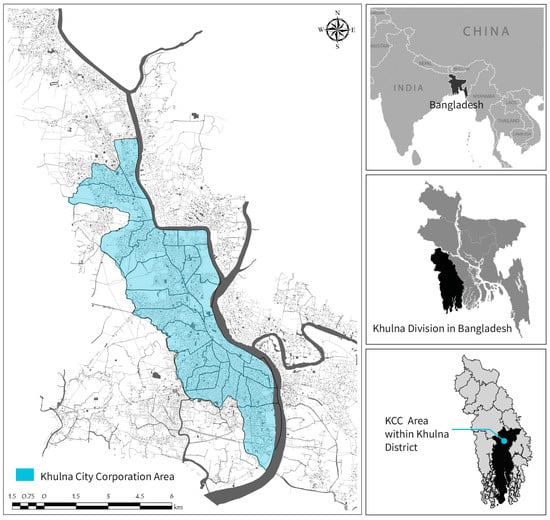
Figure 2.
Map showing the location of Khulna City in Bangladesh.
3. Materials and Methods
3.1. Semi-Structured Interviews
This study adopted a qualitative research approach by conducting semi-structured expert interviews to collect data. Due to their nature of “flexibility and adaptability” (p-22), semi-structured interviews enable researchers to be flexible and adaptable to ask questions in their interviews while still keeping track of their studies [44]. Rather than generalising a phenomenon’s understanding, this method helped the researchers better understand the participants’ unique perspectives [45] and elicit the motives behind the answers.
3.2. Sampling and Participation Requirement
The snowball sampling method was used to gather information from various types of professionals with expert knowledge [46]. Research and professional experiences in urban planning and/or flood/water management issues in urban and peri-urban areas around Khulna City were the primary concern in participant selection. Academics from architecture, urban planning, environmental science, or geography and professionals from research firms in relevant fields received priority for these interview sessions. In the initial stage, several relevant and known professionals related to the built environment in Khulna City were interviewed. Later, suggestions were taken from those informants for other suitable interview participants who also had similar experience. The interview sampling process also developed as the fieldwork progressed since interviewees recommended others, and information that emerged during the data collection process led to the need to interview others. Considering the lack of new information and with no new codes and themes generated from data collection (saturation), 23 interviews were considered sufficient [47]. Table 1 gives an overview of the participants’ profiles who were interviewed for this paper.

Table 1.
Overview of interviewees for this paper.
3.3. Conducting Interviews
Interview questions, participant information statements, and consent forms were sent to each interviewee one week before the main face-to-face interview session. A face-to-face interview session was arranged with each participant, which took 45 to 60 min for each session. A series of open-ended questions were developed before the interviews, and information was collected through a mix of semi-structured questions following an informal conversation. During the interviews, strict confidentiality and anonymity were ensured, and participants were informed of their right to withdraw. It should be noted that due to cultural protocols, the request to sign paperwork may have raised undue suspicions, affecting the answers; thus, signing the paperwork was intentionally avoided, and verbal consent was collected through the interview-recording process. Interviews were conducted during the timeframe from February 2019 to July 2019. Participants were well informed about the possibilities of publication and were provided with information based on social and political circumstances. Participants were told that they had the right to withdraw from the study at any time if their request was submitted before the final write-up date, but no participants requested this. Interviews were audio-recorded and transcribed and translated from Bangla to English. Translated transcriptions were emailed to participants to check for accuracy and further verification. In addition, the lead researcher also took independent interview notes for further reflection on the interviews. The University of Newcastle (Australia) Ethics Committee granted ethics approval and approved interview protocols for processing and analysis.
Key topics addressed through the interviews were the role of TWK in urban flood risk reduction, challenges of collecting related information and adopting TWK to reduce flood impacts, the types of TWK that exist in Khulna City, and ways of implementing TWK in the urban context. During the interview session, participants were not directly asked about the role of the three levels of the TWK framework. Instead, direct verbal (asking several open-ended questions related to traditional water knowledge) and indirect conversations were carried out during interview sessions, and literature reviews on various theoretical models helped to analyse the interview data.
3.4. Data Analysis
QSR NVivo 12.0 analysis software was used to summarise all interview data. The coding process established a way to break down large documents so that the research could identify key themes that characterise the collected data. In the first stage, initial coding [48] was adopted, comprising reading translated transcripts more than twice to become familiar with the text and lessen the possibility of misplaced content. At the time of coding, it was observed several times that the same statement could be coded more than once to fit into more than one theme. Several times, coding required modification to best fit with the possible outcomes. In the second stage, descriptive codes were formed to reduce the frequency of similar types of coding. Similarities and differences were grouped, and common themes with subthemes were elucidated from all interviews. Afterwards, analytic codes were generated from the initially developed descriptive codes with reference to the literature to elucidate common themes and subthemes. In the final stage, all the emerging themes were structured into a framework that addressed the study’s goals and, when applicable, ideas found in earlier studies and theoretical models.
The considerations based on interview data resulted in the categorisation of data into 19 subthemes under 7 themes of challenges and 14 subthemes under 6 themes of opportunities. The subthemes were further distributed within three components of the TWK framework based on their nature and execution criteria. Figure 3 depicts the distribution of themes and subthemes and their relationship with different key informants based on the interview data. It shows that researchers and urban professionals mostly revealed their concerns and methods of integration of TWK with present practices. However, government officials mostly talked about administrative difficulties and limitations. Although NGO workers and urban residents provided less information, they provided some innovative solutions that were not stated by other groups.
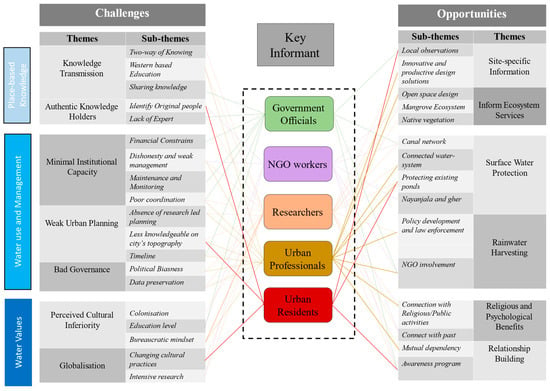
Figure 3.
Themes and subthemes identified based on interview data.
3.5. Validity and Reliability
The focus of this study was on defining and identifying the challenges and opportunities in integrating traditional water knowledge into urban planning and design. While the interviews could have been undertaken to provide information that would compare different types of traditional knowledge among professionals and communities, this was not the focus of this study. As the conclusion is based on data collection from a limited number of participants from the specific context of Khulna City, Bangladesh, the findings are not intended to be generalised to other urban contexts. However, the research process described in this paper is proposed as the starting point of an approach that can be used in other parts of the world for thinking about the issues of TWK to achieve sustainable goals with a more comparative approach and obtain further detail in other urban contexts.
4. Results
While the importance of TEK has been explored for adaptive planning in the natural resource management field for decades [49], its application to urban planning and design is rare [50]. With the understanding that urban planning and design are truly innovative and adaptive in their pursuit of resilience, innovations can then be piloted from TWK. Under a TWK-based flood-resilient model, urban planning and designs can assist in understanding how a policy or project will influence landscape processes or functions. Implemented planning policies or designs using TWK can become experiments from which experts, professionals, and decision-makers may gain new knowledge through monitoring and analysis. The results are presented and grouped into the three components of the TWK framework previously described by the authors [20] (see Figure 1). These are place-based knowledge, water use and management, and water values.
4.1. Place-Based Knowledge: Challenges and Opportunities
Following open textural coding, 102 comments were coded in the context of place-based knowledge, where the challenges were found to be knowledge transmission and the identification of knowledge holders. As well as identifying challenges in applications of TWK, interviewees also acknowledged the positive role of place-based landscape knowledge in urban design and planning as an opportunity for sourcing information on nature-based solutions, which has the potential to provide information to ecosystem services and give site-specific knowledge. Figure 4 depicts the recorded number of comments and the number of interviewees against the five themes identified under place-based knowledge. The interview discussions around place-based knowledge were found to mainly explore issues related to control over the data generated by local people based on trust issues expressed by bureaucrats, who are used to Western scientific ways of producing and monitoring information and who find it difficult to accept information generated within a largely different knowledge system.
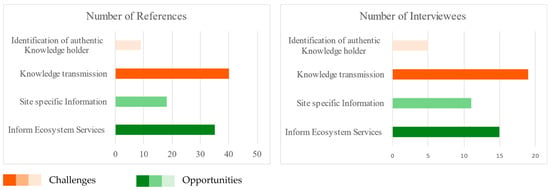
Figure 4.
Distribution of the number of comments recorded and several interviewees on place-based knowledge.
4.1.1. Knowledge Transmission
Knowledge transmission is considered a significant challenge for addressing place-based landscape knowledge when the belief system and concepts from traditional knowledge differ from those of scientific communities. There is a significant gap between the traditional/local way of knowing and the conventional/global way, typically forming a dichotomy of indigenous and non-indigenous knowledge, often referred to as the two ways of knowing [51]. Results from the interviews suggest that professionals see knowledge sharing as a one-way, top-down approach, as the interviews showed that many (three out of four) government officials asserted that local people needed to gain scientific knowledge or educate themselves. In contrast, urban professionals argued that their Western-based education system had restricted them from exploring the potentiality of local knowledge (five out of ten). The interviews showed few options involving locals in two-way communication and knowledge sharing.
The Western-knowledge-based education system promotes keeping the tradition as an ontological marker separate from modern thought and ideas [52]. Interviewees identified that the Western-based education system is making urban design professionals less innovative and less aware of contextual evidence and is failing to guide them in collecting information from local people, a significant barrier to transmitting knowledge to participants. Interviewees also found urban professionals to be biased due to their Western-knowledge-based education system, which the participants thought taught them to impose their thoughts on the margins rather than finding a way to create a platform for mutual dependency where they could explore the contextual evidence from the local knowledge holders (R 11, 2019).
Traditionally, knowledge is disseminated orally by local people and based on their pre-assumptions due to collective cultural experiences, which restricts sharing knowledge with professionals [21]. Some (six) interviewees explained that sharing knowledge is a distinct challenge for local people and urban professionals. It is challenging for planners to convey traditional water knowledge to those involved in planning processes and relevant departments. In addition, emotions, opinions, and experiences may vary from person to person and may relate to their benefits. For instance, a pond in a community can represent different values for different people. For a person who grew up near the pond, it might be linked to their childhood memories, whereas for a newcomer to that community, the pond may appear to be wasted land. Sometimes, it may be difficult for the urban planner to accommodate different perspectives from local people based on their emotional attachment rather than any logical explanation (UrP 13, 2019).
4.1.2. Identification of Authentic Knowledge Holders
To use TWK within planning, design, or other contexts, the holders of that local knowledge who are willing and interested in sharing their histories, cultures, and practices must first be found and engaged. Interviewees noted the challenge of finding the original people who could provide the appropriate TWK for a situation and relevant professionals with the skills to interpret and apply the information. In the case of water knowledge, an urban elder recommended that ongoing discussions are required to identify actual knowledgeable people and how that knowledge can be used for the benefit of others (UrE 22, 2019). Even when people come forward to share TWK, the interviewees noted that it is difficult for the urban planner and designer to be confident that all voices are heard and satisfied with the accuracy of the knowledge (UrP 13, 2019). Interviews with government professionals highlighted that a further challenge with gathering traditional knowledge information is a lack of experts who can identify the actual knowledge holders. Another interviewee added that the reliability of traditional knowledge would be lost if the collected data were ancient because circumstances may have changed, which is very common in the case of a developing country (GoV, 03, 2019).
4.1.3. Site-Specific Information
The interviews for this research demonstrate that both urban professionals and government officials agree that TWK can create site-specific solutions. According to many professional interviewees (eight out of twenty-three), it is essential to consider the knowledge and opinions of local people who know their immediate area better than those from the outside. Local people may be more likely to be aware of the best possible use of their water system, and local observations over a long period may provide a better basis for decision making. Interviewees also explained that TWK could help generate new thoughts and ideas, for example, if an urban planner is exploring innovative and productive solutions. Sometimes, the TWK solutions were considered superior to modern Western-based planning practices. Thirteen of the twenty-three interviewees were critical of adopting Western-based flood management techniques. According to them, without understanding Bangladesh’s water system, the adoption of Western countries’ approaches—where the nature of water is different—is increasing flood-related problems (Env 17, 2019).
4.1.4. Inform Ecosystem Services
About 85% of interviewees agreed that the existing built environment in Khulna City does not support the region’s natural ecosystem and is often harmful to the natural environment. However, 45% of the interviewees believed that there is still potential to integrate the natural ecosystem into urban planning, where they found that one main benefit of addressing TWK is showing positive attitudes towards the natural ecosystem and the services it can offer the community. Six interviewees believed that working with TWK can promote ecological benefits in urban open-space design, such as regulating ambient temperatures, filtering air, and reducing stormwater. Beyond the human benefit, TWK-based open-space design and planning can protect aquatic habitats and preserve biodiversity (Env 18, 2019). The landscape of Khulna City still carries the legacy of mangrove forests, which are now very scattered. A few interviewees noted that remnant mangroves could be an important source of inspiration for reintroducing the mangrove ecosystem and establishing tourism within the city. In addition, four participants mentioned the importance of native vegetation, like the coconut tree (Cocos nucifera), hogla pata (Typha elephantina roxb), and golpata (Nypa fruticans). These trees are good for low-lying areas containing flood water, and plantations of such native trees have the potential to capture and hold large quantities of rainfall overflows, buffering cities from flooding impacts (UrP 13, 2019). Gopal [53] identified the importance of coconut trees to ecosystem services, and Rajendra et al. [54] noted their effectiveness in reducing the impacts of disaster events.
4.2. Water Use and Management: Challenges and Opportunities
With the pressure of rapid urbanisation and population growth worldwide, it is highly challenging to manage the appropriate use of water and water resources. The current conventional urban design and planning practices of Khulna City have a minimal scope to address the dependency of local people on their water system; instead, the current planning practices consider water a nuisance on urban lands. This section explains the challenges and opportunities related to the use and management practices of traditional water knowledge in Khulna City based on the opinion of the professionals interviewed. About 133 comments from different professional informants were coded into nine different types of challenges to TWK under water use and management that were then grouped into three main themes: weak institutional capacity, poor urban planning, and bad governance. In contrast, 82 comments were recorded as opportunities for TWK and grouped into two themes: surface water protection and rainwater harvesting. Figure 5 represents the distribution of water use and management-related challenges and opportunities. It shows that most interviewees considered the present weak urban planning to restrict the integration of TWK into practice. The second-most commented-upon challenge is less institutional capacity, with 29% of the total comments, whereas bad governance shares 24% as a challenge for integrating TWK with urban planning and design. However, interviewees also discussed the importance of TWK for surface water protection (58%) and practicing rainwater harvesting in the urban context (32%).
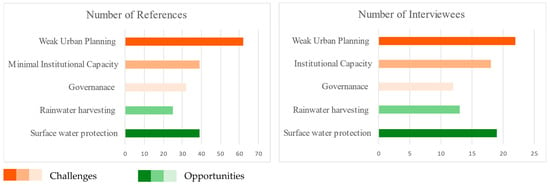
Figure 5.
Distribution of different codes on identified themes linked to water use and management-related challenges and opportunities.
4.2.1. Minimal Institutional Capacity
A lack of accountability and transparency equate to minimal institutional capacity for the integration of TWK into urban planning in developing countries of the Global South [55]. According to government officials, budgetary and financial constraints were identified as challenges for integrating TWK into urban planning for flood adaptation. Government officials talked about the considerable amount of funds required to protect existing ponds and involve local people in water issues, considering the socio-economic conditions of the locals. In contrast, two NGO interviewees, one architect and one urban planner, claimed that funding is not the central issue; it is dishonesty and weak management by officials related to government funds that are the main problem (N07, N08, Arch 15, UrP12).
Government officials also highlighted maintenance and monitoring issues, which could be a challenge for sustaining traditional water knowledge in the long run. Based on their experience on other projects, the government official interviewees revealed that after completion, most of their efforts were in vain due to a lack of proper maintenance (Gov 04, 2019). Several interviewees mentioned that considerable investment is required for an engineering-based flood risk management approach in Bangladesh. However, one environmentalist mentioned that TWK is the process of local practices involving local people in managing their water resources. Permitting them to use water resources for economic benefits will motivate them to maintain those water bodies (Env 18). An integrated, efficient institutional framework is missing in the existing urban design and planning practices of Khulna City. This is another difficulty contributing to the challenges of the minimal institutional capacity of the government that was identified by government officials from all sectors of the Khulna Development Authority (KDA), Khulna City Corporation (KCC), and Khulna Water Supply and Sewerage Authority (KWASA). The interviewees mentioned a poor coordination process among different government bodies. It was suggested that an improved framework could better distribute the roles and responsibilities of other actors related to this field. Interviewees also mentioned that various actors’ roles in urban planning overlapped, and minimal sharing exists among different government bodies.
4.2.2. Weak Urban Planning
Three subthemes that emerged and were grouped under weak urban planning describe the administrative system associated with the planning process as the absence of research, with less topographical understanding, and operating under a difficult timeline. The present urban planning practice of Khulna City is a continuation of the outdated and out-of-context urban planning adopted by the British during the colonial era of Bangladesh (1790 to 1947), which is characterised by the traditional colonial administrative system, a highly politicised bureaucracy with entrenched corruption and non-participatory planning [56], leading to less innovation and a visionless approach. Most of the urban professionals and researchers interviewed identified the absence of research-led urban planning practices as one of the significant challenges in implementing TWK in planning practices. In contrast, government officials claimed that the government organisation of Khulna City has an insufficient capacity to explore innovative and new practices, such as integrating TWK into planning processes, and they are already struggling with their limited resources and employees (Gov 03, 2019).
Many participants (five out of twelve) talked about the lack of understanding of the city’s topography and the lack of design strategies for planning the city’s growth as another issue that has resulted in the city facing regular drainage congestion, causing flooding. The growth of Khulna City should head north, where the initial development was started, based on the availability of higher lands at the bank of the Rupsha River [42]. However, the city’s recent growth is going south, comprising mainly flood-flow zones with agricultural activities. The Rupsha bridge has recently been built to connect with the capital city. The soil of the low-lying areas is not suitable for construction work. Yet, a significant amount of investment in future construction has already been made through land purchases in flood-flow zones. It can be assumed that this will increase the future risk of flooding, as the city’s topography cannot support such growth (Arch 16, 2019). Linking with the lack of understanding about topographical knowledge, many participants identified how the focus on road-based transportation corridors, instead of the navigation of existing rivers and canals (which once worked as the primary form of transport and communication), is now one of the primary reasons for the increasing flood risk and, correspondingly, a significant shift away from the traditional way of living.
Timeline is another issue of concern in integrating TWK into planning; it is difficult to collect information and document, process, and present it within the confines of these two knowledge systems. It requires a lot of documentation and updated information to work with TWK, which is challenging to include in the current planning practice in the context of Khulna City, an issue mentioned by many interviewees. In addition, some of the urban professionals (three of twelve) and government bodies (two of four) talked about the very long process of planning for the execution of government projects, and they noted that, in most cases, the areas have transformed a lot during the time between project planning and execution. Participants also indicated that physical changes around the city are happening quickly. When urban professionals go to implement previously created plans, the area may already have changed a lot. The lack of documentation of traditional water knowledge in that location creates barriers to reviving traditional water knowledge in a planned way. One of the participants suggested that much research is required first to understand to what extent the knowledge can fit with the present situation.
4.2.3. Bad Governance
The interviews showed that almost half of the urban professionals (five out of twelve) and researchers (one out of two) and two NGO workers felt very strongly about another challenge to the integration of TWK, which can be summarised as “bad governance”. A combination of a lack of willingness to execute law enforcement, extreme corruption, poor regulation, and ineffective administration can be defined as bad governance [57]. Power is a multi-faceted concept and is a dominant issue in discussions on various forms and interpretations of participation. In the present form of the governance system, power is considered to be held by high-level authorities and institutional structures, whereas local people are seen to be subjected to this power. Although the engagement of local people in the decision-making process has been recommended in policy documents, the administrative process of Khulna’s governing body has not yet created a platform where local knowledge could be gathered correctly. Government officials also discussed political biasness when selecting local people as representatives (three out of four). In most decision-making cases, the local commissioner (who represents the voice of the locals of a designated area) is the only person responsible for giving information about their locality. These interviewees explained that these local commissioners do not have the required level of awareness around traditional knowledge and, further, misuse their political power. Participants openly suggested that this single representative was inappropriate and open to corruption or false claims.
The most effective governance encourages the engagement of locals and requires the preservation of cultural values [58]. Most of the interviewees mentioned that in the structural arrangements of the present Khulna governance, there is a very limited scope to address the issues of TWK. The engagement of local people in the decision-making process is merely perceived as a protocol to be met, rather than genuine engagement and integration. Nine of the twenty-three interviewees claimed that the government was not undertaking any awareness programs to inform communities about the potential of surface water as a resource and, conversely, the flood risks on urban lands. Eleven out of the twenty-three interviewees explained that the government still needed to take action related to preserving datasets on surface water resources and had failed to adopt an integrated urban planning approach. A lack of political will to focus on flooding-related problems in Khulna was referred to as a challenge by government officials (three out of four). The officials also talked about their views that the preferences of political leaders were for complex engineering-based flood control approaches rather than the soft techniques of flood adaptation used in traditional water management practices.
4.2.4. Surface Water Protection
The most numerous comments in the interviews were about the importance of surface water protection in protecting existing canal networks, ponds, and connected water systems and community participation. Most of the urban professionals showed an interest in the idea of canal revitalisation. Khulna once had an intense network of 42 canals, of which 22 still exist and serve the city. Researchers and urban professionals believe that revitalising this canal network can restore the traditional landscape (UrP 13, 2019) and transfer the information for integrated planning practices. In support, one participant also suggested naming all the canals like roads and discussed the urgency of using canals as another mode of transportation (Arch 14, 2019). However, government professionals mentioned the financial difficulties related to revitalising the canal network and considered it an absurd plan to execute in the present situation.
Interviewees highly recommended protecting the existing ponds, which have decreased in number over time. Some talked about the alternative uses of ponds in disaster risk reduction. For example, these ponds collect excess flood water and are also useful as water sources in case of fire (R 11, 2019). Further, six participants talked about the connected water system of traditional practices, where one water body is connected to the other and helps the natural drainage system. For example, lowlands, marshlands, and ponds are containers for excess rainwater and transmitters to recharge groundwater. Canals transfer water to rivers and rivers move it towards the sea. However, the existing flood mitigation techniques in the urban planning system of Khulna are very much fragmented. One interviewee explained the role of canals parallel to the road (locally known as Nayanjola) in recharging groundwater and containing excess flood water (N 07, 2019). Another researcher suggested that keeping Nayanjola and protecting gher (a traditional method of shrimp cultivation) to collect floodwater and then discharging it into a designed urban pond or an open space is a more beneficial system than just protecting scattered ponds that are privately owned (R 09, 2019). Five participants mentioned that traditional water resources must be linked to other functional uses, which they consider more efficient in an urban context. Historically, cutting ponds to collect soil for building construction is very common in the Bengal context, which is known as the “cut and fill” [59] or “dig and dwell” [60] strategy. Urban residents suggested making ponds mandatory in all institutional and public buildings, which can work as floodwater collector points for the city (UrE 23, 2019).
4.2.5. Rainwater Harvesting
About 65% of interviewees from our research believed that introducing rainwater harvesting into policy at the household level through laws enforced by the government in Khulna could help not only deal with the water scarcity problem that the city faces during summertime but also contribute to reducing the flood risk in the urban context. However, 25% of interviewees believed that integrating rainwater into urban design practice would require vast amounts of funding, which would not suit a country like Bangladesh. A further 15% believed that an awareness program and government support could help to motivate people to accept this age-old tradition in the urban context. Seven urban professionals also mentioned that the city’s drainage system failed after continuous rainfall for two to three days. Three of them also suggested that if rainwater harvesting could be included in policy documents and made compulsory for every household, floodwater runoff could be delayed, and the city would be safe from immediate drainage problems (UrP 13, Arch 14 and R 08, 2019). Enforcement of the law by the government and changes in rules and regulations in building construction enacted with NGO involvement could help (GoV 04, 2019). Participants recommended that constructing urban ponds for each neighbourhood be as highly prioritised as road construction (Photo 20, 2019). Another planner suggested that rainwater harvesting not only fulfils the demand for water at the household level but can also be stored in rainwater collectors to stop it from contributing to increased flood risk (EnV19, 2019).
4.3. Challenges and Opportunities Related to Water Values
This research has found that mistrust and cultural changes are two major challenges working as barriers to the acceptance of local knowledge related to the water system and its integration with the urban planning and design practices of Khulna City. The value of water and local knowledge was described in the interviews as two challenges and two opportunities, with 61% of interviewees identifying perceived cultural inferiority as the major challenge for not valuing water and local knowledge. In contrast, relationship building (considered by 48% of interviewees) was identified as the biggest opportunity for working with TWK. These interviewees promoted the knowledge sharing of urban design and planning practices between locals and other stakeholders to enhance the value of local knowledge and its practices related to water use and management. Not as many interviewees also believed that working with TWK in urban planning and design can bring psychological benefits to humans to create a friendly relationship with the natural water system. Figure 6 illustrates the number of comments and interviewees of selected themes under the category of water values.
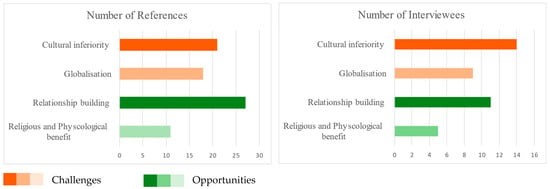
Figure 6.
Distribution of the number of interviewees and references to selected themes related to valuing water and local knowledge.
4.3.1. Cultural Inferiority
The literature shows that culturally reasonable practices are vital for gaining access to significant knowledge; however, sharing that knowledge requires relationships built on trust [61]. When considering trust issues between the government and the local people regarding acknowledging local knowledge in the planning process, four interviewees talked about perceived cultural inferiority as a barrier, where the administrative persons intentionally ignore the availability of local knowledge. The interviewees stressed that Western cultures are commonly valued more highly than Bengali culture in the decision-making process. Long-time colonisation is one of the reasons for this cultural inferiority, as mentioned by two participants during interviews.
Four participants also talked about the education level of local people. In contrast, seven participants did not think that local people needed any education to discuss water planning, as they already had experience on the topic. Additionally, it was noted that administrative officers had a sense of cultural superiority, driving the belief that locals needed education before sharing their knowledge. This attitude restricted them from valuing local knowledge. Most urban professionals blamed the authority for their ignorance and for not respecting the local knowledge that they had gained from their ancestors and long-time experiences working with nature. Of all participants, 75% agreed that local knowledge is essential, whereas 25% showed less faith in local knowledge, especially regarding water. Government officials accused local people of having less awareness and less knowledge of water use. They also demanded that, if engaging locals in projects listed by the government is required, they should always work under the direction of government agents. However, researchers claimed that the bureaucratic mindset of government organisations restricts the acceptance of local people’s opinions (R 09, 2019).
4.3.2. Globalisation
Globalisation is considered one of the significant challenges for TEK, as traditional knowledge usually has a localised ontology and lacks a global dimension, according to the academic literature [62]. Moreover, geographical distance, the spread of Western technology, and the modern emphasis on markets and projects formed outside the local context have resulted in the erosion and deliberate destruction of indigenous knowledge systems [62]. The impact of globalisation also brings change to the relationship of local communities with their water systems. Traditionally, in Khulna, people took care of the surface water resources for their benefit and use. Yet, the interviews and field studies in this research show that this is a cultural practice that has changed due to the establishment of a considerable number of tube wells for both irrigation and household purposes, effectively changing the traditional water–human relationship in this region (UrP 13, 2019). In the case of integrating TWK into urban design and practice, few participants showed concern about reviving the traditional way of living. According to their view, it will be very difficult to bring back traditions that have already been lost due to modern living. According to these interviewees, it is first required that suitable knowledge and practices that may apply to the present situation be identified and protected from further loss (UrP 13, 2019). In addition, one NGO worker suggested that intensive research is required to know what was used in the past and the potential to keep these practices. It was acknowledged that much time and work are required to apply such knowledge to the policy level in this era of globalisation (N 07, 2019).
4.3.3. Religious and Psychological Benefits
Very few interviewees highlighted the issues of religious and psychological benefits that can be contributed by exploring TWK in an urban context. Interviewees acknowledged that urbanisation could not be stopped. Still, if it is combined with traditional knowledge, an opportunity is provided to add value and connect the new generation to their traditional past. One architect observed people’s relationship with water for religious activities and suggested an innovative solution for protecting surface water on urban land. As per his recommendation, if a city-scale water reservoir can be made around a religious building, local people may be more likely to protect it due to their belief system (Arch 14, 2019).
One photographer showed his concern about the new generation growing up in an environment where they have no psychological connection to their surroundings as they had in childhood. Living in an environment where a person can smell the scent of paddy, hear the bird’s voices, know their habitat, and feel the air change undoubtedly refreshes people’s minds (Photo 21, 2019). Recalling a childhood memory, one urban elder (UrE 23) recommended keeping age-old ponds within the urban fabric to teach children to swim. In addition, many participants suggested increasing and patronising different water-related public activities (fishing, swimming, boating, gardening) in urban areas, which they considered helpful for urban people’s physical and mental health (Env 17, 2019).
4.3.4. Relationship Building
Despite the challenges of knowledge transmission or the identification of real knowledge holders, many participants considered TWK in urban planning a good platform for knowledge sharing and developing mutual dependencies between different stakeholders. The interviewees discussed the potential of developing a mutual dependency between locals and urban planners in the case of water management and exploring its potential for related economic values. For instance, when fishing, local people depend on surface water sources for an extended period. They have their traditional skills, and sharing such knowledge and incorporating it into the planning process will initiate a mutual dependency and increase awareness of managing water resources. However, these and other participants also mentioned that local knowledge is not enough to deal with the problems and that relationships with other stakeholders based on their expertise are mandatory to build flood resilience in the urban context. Some suggested considering the integration as a must rather than a choice for bringing environmental sustainability.
Six participants described integration with scientific knowledge, mutual learning, and cultural understanding and commitment as promising avenues for relationship building and initiating the possibility of developing social awareness. They considered that awareness programs were needed to provide information on managing water resources. A few interviewees (five out of twenty-three) acknowledged a need for skill development and education for local people to build a mutual dependency of trust among local people. They believed that knowledge sharing offers the opportunity for interactions between experts and laypeople and initiates awareness. These interviewees proposed cultural understanding with a commitment to respecting the water system to create benefits by developing social awareness about their water system.
5. Discussion: Mapping Opportunities with SDGs
The Sustainable Development Goals (SDGs) promote cooperation and pragmatism in selecting the best solutions to enhance sustainable living for future generations. According to D’Adamo et al. [63], the quality of life in urban areas can be envisioned by the SDGs by offering equal opportunities to all people and empowering them to actively engage in the sustainable development challenge. While Rieckmann [64] acknowledged that linking TEK with SDGs is a challenge, Kahlon and Singh [12] consider mapping SGDs to TEK as a unique opportunity to connect research pathways of Western and traditional methods. In the present era, where the focus is shifting towards practicing ecological wisdom [65,66,67], many urban design projects seek inspiration from traditional knowledge to move forward [18]. To expand such knowledge, this paper further maps the SDGs to identified opportunities suggested by the interviewees and supported by academic literature. Table 2 represents how the opportunities (identified through TWK integration) can contribute to achieving the Sustainable Development Goals. It is evident from the table that SDG 11 is the most relevant goal and offers the highest level of opportunity, given that this goal pertains to the urban context, which is the concern of this paper. The darker-grey fill colour in the grid represents opportunities for achieving SDGs directly, with a strong relationship between the identified opportunity and the SDG. At the same time, the light-grey fill colour in the grid represents a less direct relation of suggested opportunities with associated SDGs.

Table 2.
Mapping of identified opportunities to SDGs through interviewees’ quotes and literature review.
In many respects, urban dwellers depend on ecosystem services for their health and well-being [80]. This study reveals that place-based landscape knowledge can potentially inform ecosystem services. Based on 25 urban areas in Canada, the USA, and China, Elmqvist et al. [81] showed that investing in urban ecological services brings social and environmental benefits and ensures economic benefits. In other research, Bergen et al. (2001) [82] explain that including local people in the design process brings forward the benefits of knowledge of the particularities of a place, and, as a result, the local people are empowered through direct participation in shaping their environment. Every place in this world is unique. Exploring traditional knowledge can provide site-specific information to help planners and designers create solutions and achieve sustainable goals. To support this, Klemm et al. [72] showed the importance of site-specific micro-climatic analysis to ensure the proper application of design guidelines in climate-responsive Urban Green Infrastructure (UGI) design.
The health of natural ecosystems and human life depends on surface water protection, and its losses or gains directly impact regional or local sustainable development. To enhance progress reporting to achieve SDG 6, Jiang [73] developed an automatic water extraction framework to track spatial–temporal changes in surface water. Similarly, the findings of this research highlight the urgency of protecting surface water resources with multi-functional activities, the need to design green open spaces in urban areas, and the necessity of rainwater harvesting at the household level. To achieve SDG 11 and enhance urban resilience, many authors suggest the appropriate design and construction of open spaces with indigenous plants [66,67]. Access to green open spaces is recommended for improving lifespan, post-surgery recovery, stress reduction, mental health, and self-reported impression of health, all contributing to achieving SDG 7, related to greater human health and well-being [81]. In achieving SDGs, the appropriate design of open spaces plays a key role in delivering ecosystem services and connectivity [71]. On the other hand, rainwater-harvesting (RWH) systems can contribute notably towards achieving water-related Sustainable Development Goals (SDGs), and RWH is being promoted in many countries [75]. Several SDGs, such as goals 2 to 6, can be achieved by using RWH systems to support household agriculture. Research by Amos et al. [75] looked at goals 11, 12, and 15 and addressed their study potential in the context of two regions of Kenya.
This study identifies that linking multi-functional activities with surface waterbodies and urban agriculture with urban people can protect the landscape elements from encroachment and create a psychological connection between people and natural settings, which is beneficial for their mental health and well-being. In this relationship between people and their local landscape via physical work, Selman and Swanwick [83] advised that an emphasis on the landscape’s uniqueness is significant for increasing ties between locals and the environment in the modern landscape development process. Ensuring economic benefits or happiness for all people equitably in urban design and planning makes it conducive for achieving SDG 11, SDG 3, and SDG 10 [77]. The urban professional interviewees suggested that it is necessary to begin understanding the TWK system by collecting data, gathering information, and making them available to different actors for a better understanding. This research has found that integration with different institutional bodies, the linkage between researchers and urban professionals, and the involvement of locals in the decision-making process for integrating TWK are very challenging in the present context of Khulna City. This research has also found that reducing bureaucratic hierarchies, increasing opportunities for involving locals in co-design and co-production approaches, involving the community in natural resource management, and adopting incremental approaches based on learning by doing is necessary to work with the TWK framework [84], which aligns with the targets of SDG 17.
6. Conclusions
Local knowledge is critical to successfully implementing integrated water resource management, and the reform of institutions is mandatory for promoting economic growth, improving awareness, and conserving essential ecosystem services. Real-life data need to be recorded for managing traditional water resources. This research also aims to alter the attitudes of various national and state governments, as well as to recognise the information resources provided by their own communities but frequently overlooked by authorities. This research proposes that it is required to first understand what the value of traditional knowledge is towards considering how equitable benefits can be ensured through the sharing of natural resources, such as water, with the contributing communities [85]. This research recommends that improved education, employment opportunities, and financial resources be supported to build the relationship of water with people of low economic power. Moreover, when the participation of local people in the process of achieving SDGs is considered, a shift away from “top-down” governance approaches is required to ensure equitable partnership among the locals and the state. There are wider issues relating to equity and social justice regarding access to water, its uneven distribution, and its public use controlled by hands at the upper levels of the power hierarchy. The disproportionate impact of floods, water congestion, and water contamination on the urban poor has policy implications for equitable land-use planning at the city level in Khulna.
The findings indicate that urban professionals can obtain Nature-based knowledge from local key informants and integrate this traditional knowledge with urban planning for building better flood resilience. This research has revealed that TWK requires a commitment to the local context, and working with TWK means investing much time in understanding the water system. By involving local people and communities in the planning process, TWK offers multiple further benefits, such as improving water and air quality, biodiversity, and amenities, improving site-specific information, and helping to create the city’s own identity. This research also demonstrates that integrating TWK with present urban design and planning can achieve SDGs to build a sustainable future and relates most strongly to SDG 11 on sustainable cities and communities. The findings from this research can work as the starting point for urban professionals and other stakeholders to facilitate a better understanding of TWK in urban planning and design.
Author Contributions
The conceptualization, methodology, formal analysis, writing—original draft preparation, was competed by R.A.; conceptualization, writing—review and editing, and supervision, was undertaken by J.V. and I.A. All authors have read and agreed to the published version of the manuscript.
Funding
This research received no external funding.
Institutional Review Board Statement
The research has received Ethical Approval from The University of Newcastle.
Informed Consent Statement
Not applicable.
Data Availability Statement
Data is unavailable due to ethical restrictions.
Acknowledgments
This research was conducted as part of the PhD program of the lead author R.A. under the supervision of the other two authors, I.A. and J.V. The author (R.A.) would like to acknowledge the support she got from Australian Government Research Training Program (RTP) Scholarship for her PhD program and the supervisory team.
Conflicts of Interest
The authors declare no conflict of interest.
References
- Kumar, A.; Kumar, S.; Ramchiary, N.; Singh, P. Role of traditional ethnobotanical knowledge and indigenous communities in achieving Sustainable Development Goals. Sustainability 2021, 13, 3062. [Google Scholar] [CrossRef]
- UN. Transforming Our World: The 2030 Agenda for Sustainable Development; Department of Economic and Social Affairs: New York, NY, USA, 2015. [Google Scholar]
- Hall, R.P.; Ranganathan, S.; G. C., R.K. A general micro-level modeling approach to analyzing interconnected SDGs: Achieving SDG 6 and more through multiple-use water services (MUS). Sustainability 2017, 9, 314. [Google Scholar] [CrossRef]
- Wang, D.; Dong, L.; Di, S. Data-driven comparison of urban sustainability towards sustainable urban development under sustainable development goals (SDGs): A review based on bibliometric analysis. Front. Energy Res. 2023, 11, 1168126. [Google Scholar] [CrossRef]
- Leavesley, A.; Trundle, A.; Oke, C. Cities and the SDGs: Realities and possibilities of local engagement in global frameworks. Ambio 2022, 51, 1416–1432. [Google Scholar] [CrossRef] [PubMed]
- Fox, S.; Macleod, A. Localizing the SDGs in cities: Reflections from an action research project in Bristol, UK. Urban Geogr. 2023, 44, 517–537. [Google Scholar] [CrossRef]
- Kaushik, A.; Attri, S.; Kaushik, C.; Schnell, R. Climate Resilience and Environmental Sustainability Approaches: An Introduction. In Climate Resilience and Environmental Sustainability Approaches; Kaushik, A., Kaushik, C.P., Attri, S.D., Eds.; Springer: Singapore, 2021; pp. 1–8. [Google Scholar] [CrossRef]
- Berkes, F. Sacred Ecology, 3rd ed.; Routledge Taylor & Francis Group: New york, NY, USA; London, UK, 2012. [Google Scholar]
- Bwambale, B.; Muhumuza, M.; Nyeko, M. Traditional ecological knowledge and flood risk management: A preliminary case study of the Rwenzori. Jàmbá J. Disaster Risk Stud. 2018, 10, 1–10. [Google Scholar] [CrossRef]
- Gómez-Baggethun, E.; Corbera, E.; Reyes-García, V. Traditional ecological knowledge and global environmental change: Research findings and policy implications. Ecol. Soc. A J. Integr. Sci. Resil. Sustain. 2013, 18, a72. [Google Scholar] [CrossRef]
- Iloka, N.G. Indigenous knowledge for disaster risk reduction: An African perspective. Jàmbá J. Disaster Risk Stud. 2016, 8, a272. [Google Scholar] [CrossRef]
- Kahlon, L.K.; Singh, R. Understanding Linkages Between Sustainability and Traditional Ethnoecological Knowledge (TEK): A Case Study of Paudi Bhuyans in Northern Odisha, India. In Climate Resilience and Environmental Sustainability Approaches; Kaushik, A., Kaushik, C.P., Attri, S.D., Eds.; Springer: Singapore, 2021; pp. 365–378. [Google Scholar] [CrossRef]
- Das, A.; Gujre, N.; Devi, R.J.; Mitra, S. A Review on Traditional Ecological Knowledge and Its Role in Natural Resources Management: North East India, a Cultural Paradise. Environ. Manag. 2023, 72, 113–134. [Google Scholar] [CrossRef]
- Gandy, M. Landscapes of disaster: Water, modernity, and urban fragmentation in Mumbai. Environ. Plan. A 2008, 40, 108–130. [Google Scholar] [CrossRef]
- Su, M.; Zheng, Y.; Hao, Y.; Chen, Q.; Chen, S.; Chen, Z.; Xie, H. The influence of landscape pattern on the risk of urban water-logging and flood disaster. Ecol. Indic. 2018, 92, 133–140. [Google Scholar] [CrossRef]
- Caponetti, L.; Ripa, M.N. Traditional knowledge for a sustainable management of water resources: The “cuniculi” of Tuscania. Plurimondi 2011, 8, 71–89. [Google Scholar]
- Jackson, S.; Tan, P.-L.; Mooney, C.; Hoverman, S.; White, I. Principles and guidelines for good practice in Indigenous engagement in water planning. J. Hydrol. 2012, 474, 57–65. [Google Scholar] [CrossRef]
- Meudler, B.D.; Shannon, K. Water Urbanisms East; Series 2; Park Books: Zurich, Switzerland, 2013. [Google Scholar]
- Thaitakoo, D.; McGrath, B.; Srithanyarat, S.; Palopakon, Y. Bangkok: The ecology and design of an aqua-city. In Resilience in Ecology and Urban Design; Springer: Dordrecht, The Netherlands, 2013; pp. 427–442. [Google Scholar]
- Asad, R.; Ahmed, I.; Vaughan, J.; von Meding, J. Traditional water knowledge: Challenges and opportunities to build resilience to urban floods. Int. J. Disaster Resil. Built Environ. 2022, 13, 1–13. [Google Scholar] [CrossRef]
- Bussey, J.; Davenport, M.A.; Emery, M.R.; Carroll, C. “A lot of it comes from the heart”: The nature and integration of ecological knowledge in tribal and nontribal forest management. J. For. 2016, 114, 97–107. [Google Scholar] [CrossRef]
- Chen, C.; Meurk, C.; Chen, J.; Lv, M.; Wen, Z.; Jiang, Y.; Wu, S. Restoration design for Three Gorges Reservoir shorelands, combining Chinese traditional agro-ecological knowledge with landscape ecological analysis. Ecol. Eng. 2014, 71, 584–597. [Google Scholar] [CrossRef]
- Liao, K.-H.; Le, T.A.; Van Nguyen, K. Urban design principles for flood resilience: Learning from the ecological wisdom of living with floods in the Vietnamese Mekong Delta. Landsc. Urban Plan. 2016, 155, 69–78. [Google Scholar] [CrossRef]
- Martin, J.F.; Roy, E.D.; Diemont, S.A.; Ferguson, B.G. Traditional ecological knowledge (TEK): Ideas, inspiration, and designs for ecological engineering. Ecol. Eng. 2010, 36, 839–849. [Google Scholar] [CrossRef]
- Shannon, K. Eco-engineering for water: From soft to hard and back. In Resilience in Ecology and Urban Design; Springer: Dordrecht, The Netherlands, 2013; pp. 163–182. [Google Scholar] [CrossRef]
- Ayeni, A.; Soneye, A.; Badru, F. Adaptation to Water Stress in Nigeria Derived Savanna Area: The Indigenous Knowledge and Socio-Cultural Nexus of Management and Humanitarian Services. J. Manag. Policy Pract. 2014, 15, 78. [Google Scholar]
- Gautam, D. Water Management through Indigenous Knowledge: A Case of Historic Settlement of Bhaktapur City, Nepal; Anchor Academic Publishing (aap_verlag): Hamburg, Germany, 2014. [Google Scholar]
- Wilson, N.J.; Harris, L.M.; Joseph-Rear, A.; Beaumont, J.; Satterfield, T. Water is medicine: Reimagining water security through Tr’ondëk Hwëch’in relationships to treated and traditional water sources in Yukon, Canada. Water 2019, 11, 624. [Google Scholar] [CrossRef]
- Wenzel, G.W. From TEK to IQ: Inuit Qaujimajatuqangit and Inuit cultural ecology. Arct. Anthropol. 2004, 41, 238–250. [Google Scholar] [CrossRef]
- Houde, N. The six faces of traditional ecological knowledge: Challenges and opportunities for Canadian co-management arrangements. Ecol. Soc. 2007, 12, 34. [Google Scholar] [CrossRef]
- Chen, C.; Meurk, C.D.; Cheng, H.; Lv, M.; Chen, R.; Wu, S. Incorporating local ecological knowledge into urban riparian restoration in a mountainous region of Southwest China. Urban For. Urban Green. 2016, 20, 140–151. [Google Scholar] [CrossRef]
- Yu, K.; Lei, Z.; Dihua, L. Living with water: Flood adaptive landscapes in the Yellow River Basin of China. J. Landsc. Archit. 2008, 3, 6–17. [Google Scholar] [CrossRef]
- Mavhura, E.; Manyena, S.B.; Collins, A.E.; Manatsa, D. Indigenous knowledge, coping strategies and resilience to floods in Muzarabani, Zimbabwe. Int. J. Disaster Risk Reduct. 2013, 5, 38–48. [Google Scholar] [CrossRef]
- Paul, S.K.; Routray, J.K. Flood proneness and coping strategies: The experiences of two villages in Bangladesh. Disasters 2010, 34, 489–508. [Google Scholar] [CrossRef]
- Hooli, L.J. Resilience of the poorest: Coping strategies and indigenous knowledge of living with the floods in Northern Namibia. Reg. Environ. Chang. 2016, 16, 695–707. [Google Scholar] [CrossRef]
- Alam, A.A.; Asad, R.; Parvin, A. Climate change adaptation through grassroots responses: Learning from the “Aila” affected coastal settlement of Gabura, Bangladesh. In Handbook of Climate Change Adaptation; Filtho, W.L., Ed.; Springer: Berlin/Heidelberg, Germany, 2015; pp. 2011–2034. [Google Scholar] [CrossRef]
- Rahman, S.; Rahman, M.A. Climate extremes and challenges to infrastructure development in coastal cities in Bangladesh. Weather Clim. Extrem. 2015, 7, 96–108. [Google Scholar] [CrossRef]
- Shannon, K.; Manawadu, S. Indigenous landscape urbanism: Sri Lanka’s reservoir & tank system. J. Landsc. Archit. 2007, 2, 6–17. [Google Scholar]
- United Nations. Goal 11: Make Cities and Human Settlements Inclusive, Safe, Resilient and Sustainable. 2022. Available online: https://sdgs.un.org/goals/goal11 (accessed on 6 December 2022).
- Esraz-Ul-Zannat, M.; Islam, I. A Study on Land Use Policies of Khulna Structure Plan 2000–2020 in the Light of Climate Change Induced Flood Scenario. J. Bangladesh Inst. Plan. ISSN 2015, 8, 23–33. [Google Scholar]
- Nillesen, A.L.; zum Felde, M.; Pfannes, E.; Meyer, H.; Klijn, O. Water as Leverage: Design Studies for Khulna, Chennai and Semarang. In SeaCities; Baumeister, J., Bertone, E., Burton, P., Eds.; Springer: Singapore, 2021; pp. 133–169. [Google Scholar] [CrossRef]
- Favaro, S. Remoulding Topography. In Proceedings of the 4th International Conference of the International Forum on Urbanism (IFoU), Delft, The Netherlands, 26–28 November 2009. [Google Scholar]
- Moniruzzaman, M.; Roy, A.; Bhatt, C.; Gupta, A.; An, N.; Hassan, M. Impact analysis of urbanization on land use land cover change for Khulna City, Bangladesh using temporal landsat imagery. In Proceedings of the International Archives of the Photogrammetry, Remote Sensing and Spatial Information Sciences ISPRS TC V Mid-Term Symposium “Geospatial Technology—Pixel to People”, Dehradun, India, 20–23 November 2018. [Google Scholar]
- Ruslin, R.; Mashuri, S.; Rasak, M.S.A.; Alhabsyi, F.; Syam, H. Semi-structured Interview: A methodological reflection on the development of a qualitative research instrument in educational studies. IOSR J. Res. Method Educ. (IOSR-JRME) 2022, 12, 22–29. [Google Scholar]
- McGrath, C.; Palmgren, P.J.; Liljedahl, M. Twelve tips for conducting qualitative research interviews. Med. Teach. 2019, 41, 1002–1006. [Google Scholar] [CrossRef]
- Parker, C.; Scott, S.; Geddes, A. Snowball Sampling; SAGE Research Methods Foundations: Cheltenham, UK, 2019. [Google Scholar]
- Hennink, M.; Kaiser, B.N. Sample sizes for saturation in qualitative research: A systematic review of empirical tests. Soc. Sci. Med. 2022, 292, 114523. [Google Scholar] [CrossRef] [PubMed]
- Saldaña, J. The Coding Manual for Qualitative Researchers; SAGE: London, UK, 2021. [Google Scholar]
- Berkes, F.; Colding, J.; Folke, C. Rediscovery of traditional ecological knowledge as adaptive management. Ecol. Appl. 2000, 10, 1251–1262. [Google Scholar] [CrossRef]
- Yli-Pelkonen, V.; Kohl, J. The role of local ecological knowledge in sustainable urban planning: Perspectives from Finland. Sustain. Sci. Pract. Policy 2005, 1, 3–14. [Google Scholar] [CrossRef]
- Muller, S. Two ways’: Bringing indigenous and nonindigenous knowledges together. In Country, Native Title and Ecology; ANU Press: Canberra, Australia, 2012; pp. 59–79. [Google Scholar]
- Molden, O.C.; Meehan, K. Sociotechnical imaginaries of urban development: Social movements around “traditional” water infrastructure in the Kathmandu Valley. Urban Geogr. 2018, 39, 763–782. [Google Scholar] [CrossRef]
- Gopal, M. Opportunity to sustain coconut ecosystem services through recycling of the palm leaf litter as vermicompost: Indian scenario (a technology/research note). Cord 2010, 26, 14. [Google Scholar] [CrossRef]
- Rajendra, I.A.; Sumariati, D.A.R. The role of coconut plants in relation to disaster management in the tropical coastal regions. Proc. MATEC Web Conf. 2018, 229, 01012. [Google Scholar] [CrossRef][Green Version]
- Horn, F.; Elagib, N.A. Building socio-hydrological resilient cities against flash floods: Key challenges and a practical plan for arid regions. J. Hydrol. 2018, 564, 125–132. [Google Scholar] [CrossRef]
- Swapan, M.S.H. Realities of community participation in metropolitan planning in Bangladesh: A comparative study of citizens and planning practitioners’ perceptions. Habitat Int. 2014, 43, 191–197. [Google Scholar] [CrossRef]
- Gel’man, V. Political foundations of bad governance in post-Soviet Eurasia: Towards a research agenda. East Eur. Politics 2017, 33, 496–516. [Google Scholar] [CrossRef]
- Roughley, A.; Williams, S. The Engagement of Indigenous Australians in Natural Resource Management: Key Findings and Outcomes from Land & Water Australia and the Broader Literature; Final Report to Land & Water Australia: Canberra, Australia, 2007. [Google Scholar]
- Shannon, K.; De Meulder, B.; d’Auria, V.; Gosseye, J. Water Urbanisms; SUN Academia: Amsterdam, The Netherlands, 2008. [Google Scholar]
- Mowla, Q.A. Water Urbanism: A Prospective Study on Dhaka. TOJSAT 2013, 3, 205–212. [Google Scholar]
- Escott, H.; Beavis, S.; Reeves, A. Incentives and constraints to Indigenous engagement in water management. Land Use Policy 2015, 49, 382–393. [Google Scholar] [CrossRef]
- Gómez-Baggethun, E.; Reyes-García, V. Reinterpreting change in traditional ecological knowledge. Hum. Ecol. 2013, 41, 643–647. [Google Scholar] [CrossRef]
- D’Adamo, I.; Gastaldi, M.; Ioppolo, G.; Morone, P. An analysis of Sustainable Development Goals in Italian cities: Performance measurements and policy implications. Land Use Policy 2022, 120, 106278. [Google Scholar] [CrossRef]
- Rieckmann, M. Learning to transform the world: Key competencies in Education for Sustainable Development. Issues Trends Educ. Sustain. Dev. 2018, 39, 39–59. [Google Scholar]
- Spirn, A.W. Ecological urbanism: A framework for the design of resilient cities. In The Ecological Design and Planning Reader; Ndubisi, F.O., Ed.; Island Press: Washington, DC, USA, 2014; pp. 557–571. [Google Scholar]
- Steiner, F. Frontiers in urban ecological design and planning research. Landsc. Urban Plan. 2014, 125, 304–311. [Google Scholar] [CrossRef]
- Young, R.F. Modernity, postmodernity, and ecological wisdom: Toward a new framework for landscape and urban planning. Landsc. Urban Plan. 2016, 155, 91–99. [Google Scholar] [CrossRef]
- Balasubramanian, M. Urban Ecosystem Services and Sustainable Human Well-Being. In The Palgrave Encyclopedia of Urban and Regional Futures; Springer International Publishing: Cham, Switzerland, 2020; pp. 1–5. [Google Scholar] [CrossRef]
- Enssle, F.; Kabisch, N. Urban green spaces for the social interaction, health and well-being of older people—An integrated view of urban ecosystem services and socio-environmental justice. Environ. Sci. Policy 2020, 109, 36–44. [Google Scholar] [CrossRef]
- Russell, C. SDG 11: Sustainable Cities and Communities from backyards to bilolinks: Royal Botanic Gardens Victoria’s role in Urban Greening. BGjournal 2018, 15, 31–33. [Google Scholar]
- Wang, J.; Foley, K. Assessing the performance of urban open space for achieving sustainable and resilient cities: A pilot study of two urban parks in Dublin, Ireland. Urban For. Urban Green. 2021, 62, 127180. [Google Scholar] [CrossRef]
- Klemm, W.; Lenzholzer, S.; van den Brink, A. Developing green infrastructure design guidelines for urban climate adaptation. J. Landsc. Archit. 2017, 12, 60–71. [Google Scholar] [CrossRef]
- Jiang, Z.; Jiang, W.; Ling, Z.; Wang, X.; Peng, K.; Wang, C. Surface water extraction and dynamic analysis of baiyangdian lake based on the google earth engine platform using sentinel-1 for reporting sdg 6.6. 1 indicators. Water 2021, 13, 138. [Google Scholar] [CrossRef]
- Alcamo, J. Water quality and its interlinkages with the Sustainable Development Goals. Curr. Opin. Environ. Sustain. 2019, 36, 126–140. [Google Scholar] [CrossRef]
- Amos, C.C.; Rahman, A.; Gathenya, J.M.; Friedler, E.; Karim, F.; Renzaho, A. Roof-harvested rainwater use in household agriculture: Contributions to the sustainable development goals. Water 2020, 12, 332. [Google Scholar] [CrossRef]
- Rahman, A. Rainwater Harvesting for Sustainable Developments: Non-Potable Use, Household Irrigation and Stormwater Management. Water 2021, 13, 3460. [Google Scholar] [CrossRef]
- Cassarino, M.; Shahab, S.; Biscaya, S. Envisioning happy places for all: A systematic review of the impact of transformations in the urban environment on the wellbeing of vulnerable groups. Sustainability 2021, 13, 8086. [Google Scholar] [CrossRef]
- Sudarmonowati, E. Implementation of Response to Lima Action Plan in Indonesia: Strategy and Progress in Relation to SDGs. Proc. IOP Conf. Ser. Earth Environ. Sci. 2019, 298, 012020. [Google Scholar] [CrossRef]
- Vaidya, H.; Chatterji, T. SDG 11 Sustainable Cities and Communities: SDG 11 and the New Urban Agenda: Global Sustainability Frameworks for Local Action. In Actioning the Global Goals for Local Impact: Towards Sustainability Science, Policy, Education and Practice; Springer: Singapore, 2020; pp. 173–185. [Google Scholar]
- Kiddle, G.L.; Pedersen Zari, M.; Blaschke, P.; Chanse, V.; Kiddle, R. An oceania urban design agenda linking ecosystem services, nature-based solutions, traditional ecological knowledge and wellbeing. Sustainability 2021, 13, 12660. [Google Scholar] [CrossRef]
- Elmqvist, T.; Setälä, H.; Handel, S.; Van Der Ploeg, S.; Aronson, J.; Blignaut, J.N.; Gomez-Baggethun, E.; Nowak, D.; Kronenberg, J.; De Groot, R. Benefits of restoring ecosystem services in urban areas. Curr. Opin. Environ. Sustain. 2015, 14, 101–108. [Google Scholar] [CrossRef]
- Bergen, S.D.; Bolton, S.M.; Fridley, J.L. Design principles for ecological engineering. Ecol. Eng. 2001, 18, 201–210. [Google Scholar] [CrossRef]
- Selman, P.; Swanwick, C. On the meaning of natural beauty in landscape legislation. Landsc. Res. 2010, 35, 3–26. [Google Scholar] [CrossRef]
- Sharifi, A.; Yamagata, Y. Resilience-oriented urban planning. In Resilience-Oriented Urban Planning; Springer Cham: Edinburg, UK, 2018; pp. 3–27. [Google Scholar]
- Slikkerveer, L.J. Ethnoscience,’TEK’and its application to conservation. In Cultural and Spiritual Values of Biodiversity: A Complementary Contribution to the Global Biodiversity Assessment; Intermediate Technology Publications: London, UK, 1999; pp. 167–258. [Google Scholar]
Disclaimer/Publisher’s Note: The statements, opinions and data contained in all publications are solely those of the individual author(s) and contributor(s) and not of MDPI and/or the editor(s). MDPI and/or the editor(s) disclaim responsibility for any injury to people or property resulting from any ideas, methods, instructions or products referred to in the content. |
© 2023 by the authors. Licensee MDPI, Basel, Switzerland. This article is an open access article distributed under the terms and conditions of the Creative Commons Attribution (CC BY) license (https://creativecommons.org/licenses/by/4.0/).
